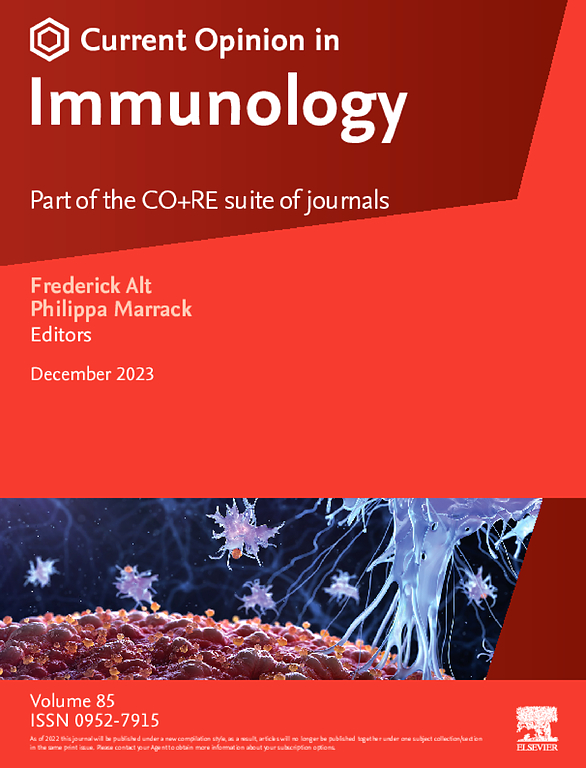From metabolomics to transfusion-associated immunomodulation
IF 5.8
2区 医学
Q1 IMMUNOLOGY
引用次数: 0
Abstract
Purpose of review
This review summarizes recent advances in metabolomics that have enhanced our understanding of transfusion-related immunomodulation (TRIM), highlighting how biochemical changes in stored blood products — with a focus on packed red blood cells — affect recipient immune responses.
Recent findings
Metabolomics has revealed critical biochemical shifts — termed storage lesions — in blood products, notably accumulation of oxidized lipids, extracellular vesicles, and hemolysis-derived molecules, such as free heme and iron. These metabolites influence recipient immunity by triggering both inflammatory and immunosuppressive pathways, mediated through mechanisms involving redox imbalance, inflammasome activation, and modulation of immune cell metabolism. Studies underscore that the immunological outcomes of transfusions are shaped not only by storage duration but also by donor-specific metabolic profiles influenced by genetics, diet, and environmental exposures. Metabolic profiling has identified novel biomarkers, such as hypoxanthine and kynurenine, which correlate with transfusion quality and immunological impact.
Summary
Metabolomics has transformed our understanding of TRIM, emphasizing that transfusion is an active biochemical intervention rather than passive fluid replacement. Moving forward, integrating metabolomic insights into transfusion medicine promises personalized strategies — selecting blood units based on metabolic rather than chronological age and donor characteristics — thus improving safety and clinical outcomes in transfusion recipients.
从代谢组学到输血相关免疫调节
本文综述了代谢组学的最新进展,这些进展增强了我们对输血相关免疫调节(TRIM)的理解,重点介绍了储存血液制品中的生化变化(重点是填充红细胞)如何影响受体免疫反应。代谢组学最近的发现揭示了血液制品中关键的生化变化-称为储存病变,特别是氧化脂质,细胞外囊泡和溶血衍生分子(如游离血红素和铁)的积累。这些代谢物通过触发炎症和免疫抑制途径影响受体免疫,介导的机制包括氧化还原失衡、炎性体激活和免疫细胞代谢调节。研究强调,输血的免疫学结果不仅受储存时间的影响,还受受遗传、饮食和环境暴露影响的供者特异性代谢谱的影响。代谢分析已经确定了新的生物标志物,如次黄嘌呤和犬尿氨酸,它们与输血质量和免疫影响相关。代谢组学改变了我们对TRIM的理解,强调输血是一种主动的生化干预,而不是被动的液体替代。展望未来,将代谢组学见解整合到输血医学中有望实现个性化策略——根据代谢而不是实际年龄和献血者特征选择血液单位——从而提高输血接受者的安全性和临床结果。
本文章由计算机程序翻译,如有差异,请以英文原文为准。
求助全文
约1分钟内获得全文
求助全文
来源期刊
CiteScore
13.30
自引率
1.40%
发文量
94
审稿时长
67 days
期刊介绍:
Current Opinion in Immunology aims to stimulate scientifically grounded, interdisciplinary, multi-scale debate and exchange of ideas. It contains polished, concise and timely reviews and opinions, with particular emphasis on those articles published in the past two years. In addition to describing recent trends, the authors are encouraged to give their subjective opinion of the topics discussed.
In Current Opinion in Immunology we help the reader by providing in a systematic manner: 1. The views of experts on current advances in their field in a clear and readable form. 2. Evaluations of the most interesting papers, annotated by experts, from the great wealth of original publications.
Current Opinion in Immunology will serve as an invaluable source of information for researchers, lecturers, teachers, professionals, policy makers and students.
Current Opinion in Immunology builds on Elsevier''s reputation for excellence in scientific publishing and long-standing commitment to communicating reproducible biomedical research targeted at improving human health. It is a companion to the new Gold Open Access journal Current Research in Immunology and is part of the Current Opinion and Research(CO+RE) suite of journals. All CO+RE journals leverage the Current Opinion legacy-of editorial excellence, high-impact, and global reach-to ensure they are a widely read resource that is integral to scientists'' workflow.

 求助内容:
求助内容: 应助结果提醒方式:
应助结果提醒方式:


